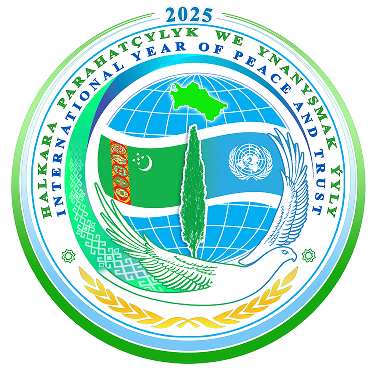Ashgabat discusses aspects of serial nomination of Silk Road to UNESCO World Heritage List

The fifth meeting of the Coordinating Committee on the World Heritage Serial Nomination of the Silk Road has started at the Ministry of Foreign Affairs of Turkmenistan.
Plenary meetings are set to focus on preparing the transnational serial nomination of monuments closely related to caravan trade between the East and the West in ancient and middle age times.
As the great historical legacy, the Silk Road today provides powerful impulse towards bringing nations and countries closer together, helps to establish political, trade-economic, cultural-humanitarian relations among them, promotes better mutual understanding and cooperation, and lays the groundwork for closer relations between states and regions, President Gurbanguly Berdimuhamedov said.
In this day and age, the common experience of the Silk Road sets a solid foundation for introducing new forms of partnership in the Eurasian area, identifying key areas of geopolitics, geoeconomics, and humanitarian activities. Announced by the Turkmen leader in recent years, international initiatives are aimed to create favorable conditions for building integrated, modern, high-technology infrastructure systems along ancient routes of the Silk Road, implementing multi-faceted projects designed to strengthen interregional and intercontinental cooperation in the context of the East-West and North-South transport corridors, and unleashing resource, production, technological potential.
President Gurbanguly Berdimuhamedov-authored book ‘Turkmenistan – the Heart of the Silk Road’ examines the phenomenon and explains the overriding importance of the route in exchanging not only commodities and goods, but also cultural values, ideas and knowledge. In this context, the Silk Road serves as the most striking and earliest example of political and cultural integration of peoples on the continent. Participants in the meeting, co-organized by the UNESCO World Heritage Center and the UNESCO Cluster Office, the Ministry of Foreign Affairs of Turkmenistan and the Turkmen National Commission for UNESCO, were shown a film and given a presentation devoted to the book and this year’s slogan.
Then, representatives of national commissions of the Intergovernmental Coordinating Committee and experts from fourteen countries – Afghanistan, India, Iran, China, Kazakhstan, Kyrgyzstan, Nepal, Pakistan, the Republic of Korea, Tajikistan, Turkey, Turkmenistan, Uzbekistan and Japan discussed the state of conservation of the Silk Road sites and ongoing efforts targeted at thematic studies, as well as decided on the nomination strategy.
Among those attending the meeting are also representatives of UNESCO, in particular senior officials of the UNESCO Regional Office for Asia and the Pacific, the International Institute for Central Asian Studies, experts from the International Council on Monuments and Sites (ICOMOS), renowned scientists, archeologists, orientalists from different countries, including Great Britain, the Russian Federation, and others.
Meeting attendees gave consideration to several projects designed to further cooperate in serial nomination of the Silk Road and ensure coordinated efforts of the countries, once crossed by routes merchants, travelers, preachers, missioners, and scientists used to travel. Over the centuries, they created ‘transport corridors’ between cities and civilizations, not only stimulating economic development and cross-cultural interaction, but also building bridges of friendship and understanding among peoples. These were the first tentative steps towards globalization and understanding of universal human values.
It is the ‘corridor’ approach that has been adopted to accurately identify sections of the Silk Road with the sites to be nominated to the UNESCO World Heritage List. One of today’s meetings centered on drawing up Management Strategies for the Silk Road Heritage Corridors in Central Asia, improved coordination in this area, and initiatives in the field of sustainable tourism and development.
At present, the Coordinating Committee is designing a general management policy to govern all UNESCO World Heritage sites along the Silk Road. This will enable to define parameters and formulate management objectives. Each participating country will be responsible for adhering to them in line with its national legislation, monument protection system, etc. Indeed, the Coordinating Committee is faced with a massive task of determining a vast number of sites, located along the Silk Road, and choosing the ones, which showcase the paramount importance of this historical route.
The Coordinating Committee also has a substantial role to play in creating a computerized database for experts to deal with various aspects of the Silk Road and in setting up working groups at regional and international levels to carry out research activities. In addition, the Committee provides communication, consultation and information support platforms for the nomination process, exchange of expertise, helps to develop common standards for documentation and maps of the Silk Road, and maintains close cooperation with international and regional organizations on these issues.
Primary emphasis in this work is on a concept of universal heritage rather than on local and ethnic heritage. For centuries, the Silk Road contributed to vigorous economic and cultural exchanges, as well as mutual influence of different cultures and civilizations. It is no coincidence that today the United Nations World Tourism Organization has recognized the Silk Road as one of the most powerful brands, which has yet untapped enormous potential. It is perfectly obvious that areas located along its corridors offer optimal conditions for transnational tourist projects implementation through combined efforts.
Tomorrow, the forum will continue its work to address sea routes of the Silk Road and finalize a plan of activities. Seminars will be concurrently organized for representatives of the participating countries to harmonize the nomination of some corridors of the Silk Road to the UNESCO World Heritage List.
Ashgabat has also hosted an expert meeting on the Traditional Sports and Games Themes of the Interactive Atlas of Cultural Interactions along the Silk Road.
Those speaking at the meeting noted that in the context of globalization the Silk Road is seen as an illustrative example of longstanding heritage, exchanges, dialogue and cooperation. To this end, UNESCO has started to develop the Interactive Atlas of Cultural Interactions along the Silk Road to demonstrate the variety and specific features of cross-cultural influence of the Silk Road in different parts of the world, applying information and communications technologies (ICT) and multimedia.
The project will indicate a need for cooperation with a remarkably wide circle of interested parties, including specialized institutions, government and non-government agencies, partners from the private sectors, foundations, mass media, and experts.
The meeting outlined the following key themes to be explored and included in the Atlas: science, technology and know-how, pharmacology and medicine, traditional costume and clothes, religion and spirituality, mythology and fantasy, languages and literature, arts and music, rituals and ceremonies, food production and gastronomy, traditional sports and games, and others.
Some 15 foreign experts, invited to attend the Ashgabat meeting, will consider historical contexts for the development of sports and national games, the processes and ways, which influenced their diffusion along the Silk Road, their adoption from other cultures, their traditional links with folk art and literature, and their influences on contemporary cultures. This will help to develop approaches, methods and instruments to better showcase the sports, which were popular along the legendary route.
In view of the fact that UNESCO is a leading UN agency, which also promotes youth sport, physical education and sport development programs, these issues are seen as another key area of cooperation with Turkmenistan in the field of traditional national sports protection and revival. Various aspects of cooperation with UNESCO will receive special attention at an international conference entitled ‘The importance of the Silk Road: Present and Future Development’ to be held in Ashgabat on December 6.
A cultural program for the guests offers sightseeing tours of Ashgabat and a visit to the Parthian Fortress of Nisa, a Word Heritage Site.


 الأخبار
الأخبار